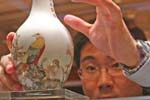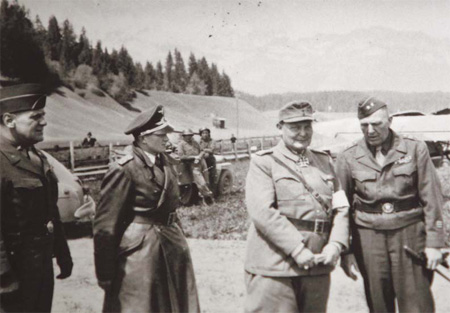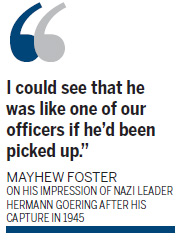Specials
Pilot recalls captured Nazi leader
Updated: 2011-01-31 07:54
By Matt Volz (China Daily)
|
In this May 9, 1945 photo provided by Brigadier General Mayhew Foster, captured Nazi leader Hermann Goering (second from right) stands on the tiny airstrip outside Kitzbuhel, Austria, before being transported back to Germany for interrogation. Provided by Mayhew Foster / Associated Press |
|
|
MISSOULA, Montana - Captain Mayhew Foster had an extraordinary mission: Fly captured Nazi leader Hermann Goering to the 7th Army's headquarters for interrogation.
Then he took one look at the one-time heir to Adolf Hitler and commander of the fearsome Luftwaffe - all 136 kg of him - and knew he needed a bigger plane.
It was May 9, 1945, the day after World War II ended in Europe. Goering, Foster and a group of officers from the Army's 36th Infantry Division gathered on a tiny airstrip outside Kitzbuhel, Austria, to transport the highly-prized war prisoner back to Germany in an unarmed, two-man reconnaissance plane.
"They wanted to get him back where he could be debriefed. There was a strong rumor that in a mountainside in the Alps right down there in Bavaria there was a concentration of (German) military," Foster said. "He just acted as though it was a nice, friendly trip."
Mayhew Foster, now 99 and living in a Missoula nursing home, recently recounted his rare one-on-one encounter with one of the most wanted Nazi leaders. Foster went on to become brigadier general of the Montana National Guard and was awarded the French Legion of Honor for his World War II service, but it was this mission that stood out as the highlight of an illustrious military career.
Goering, 52, had surrendered to the US Army's 36th Infantry Division the day before. He had fallen out of favor with Hitler and hadn't played an active role at the end of the war, though he remained Reichsmarschall of Nazi Germany.
Before his capture, Goering wrote a letter to General Dwight D. Eisenhower, Supreme Allied Commander in Europe, offering to work with Eisenhower on the conditions of the German army's surrender, according to an account of Goering's capture by Brigadier General Robert Stack kept by the 36th Infantry Division Association.
After receiving the letter, Stack and a group of soldiers drove from the division's base near Kitzbuhel across the border into Germany and intercepted a convoy that included Goering, his wife, daughter, sister-in-law, household servants and military aides, according to the account.
Goering agreed to surrender unconditionally but asked that his family be cared for, and the Nazi leader was delivered to Foster for transport the next day.
Foster, who was 33 at the time, said he didn't fear getting shot down carrying such precious cargo alone in an unescorted, unarmed plane. He didn't worry about Goering taking advantage of the lack of a guard to wrest control of the aircraft.
The main problem, he said, was getting the two of them off the ground - the nimble, lightweight Piper L4 that Foster piloted in his artillery spotting missions wouldn't support both him and Goering. But the division only had the small airstrip that was fine for Foster's aircraft, but was problematic for taking off and landing larger planes.
They'd have to upgrade to the one L5 in the division's inventory, a slightly larger aircraft Foster hadn't flown in years.
Goering stood on the tiny airstrip in a plain, gray uniform that was unadorned but for a pistol at his hip and a medal around his neck. Still wearing the pistol, he stepped toward the plane. A Goering aide emerged from the group that had gathered and relieved Goering of the weapon.
The Nazi leader settled into the back seat and tried to fasten his seat belt. It wouldn't stretch across his belly. He held the strap in his hand, looked at Foster and said, "Das goot!" - that's good.
A photograph of that moment shows Foster in the cockpit and Goering seated directly behind him, his elbow jauntily propped on the plane's fuselage.
The two men spent the 55-minute flight from Kitzbuhel to Augsburg, Germany, conversing in a mix of German and English. Foster said Goering avoided any talk of Hitler or the war but appeared to relish pointing out the sites below them.
"He acted as though he was going on a sightseeing tour, or really as though I was going on a sightseeing tour and he was showing me where he grew up," Foster said. "I had a .45 in a shoulder holster, but he couldn't reach that. But neither could I, because I had two hands controlling the plane."
He described Goering as sharp, friendly and witty, even cracking a joke when Foster asked him when Germany began manufacturing jets.
"Too late," Goering replied, according to Foster.
At the time, Foster was somewhat less generous in describing the man. In a letter to his wife, Virginia Lou Foster, written soon after the mission, Foster told her that the Nazi leader was "effeminate" and "gave me the creeps".
"Several times I had the impulse to turn the plane over and see if I could shake him out but he was wedged in like a champagne cork," Foster wrote.
After landing, Foster asked his passenger to sign a blank flight report. The prisoner scrawled "Hermann Goering Reichsmarschall" across the paper, which Foster folded and put in his pocket.
It's a document that he still has, one of Foster's most prized possessions alongside a collection of photographs of Goering, Hitler and other snapshots from the days of the Third Reich.
There was just a single jeep at the airstrip to meet the arriving flight carrying the world's most famous war prisoner. Foster rode with Goering to the gates of the 7th Army Headquarters and formally turned him over to the intelligence officer without ceremony.
It turned out, Foster learned later, those rumors of German troops hiding in the Bavarian Alps were untrue. Goering stood trial at Nuremberg, and the next year he was found guilty of war crimes.
Goering was sentenced to hang, but he committed suicide instead by swallowing a cyanide capsule.
Sixty-five years later, Foster is trim, sharp and carries himself as a former military officer.
He still reflects on his rare insight into the Nazi leadership, and he recognizes that the experience had shifted his perceptions of the enemy. It allowed him to see the human side of those he had only known as caricatures.
"I could see that he was like one of our officers if he'd been picked up," Foster said. "I wouldn't say it changed my view of the war but it showed me that there are ..." He broke off.
"Well, I questioned all that we knew about these vicious people," he said.
Associated Press
Specials

Share your China stories!
Foreign readers are invited to share your China stories.

Art auctions
China accounted for 33% of global fine art sales.

Waiting for drivers' seat
Lack of sponsorship appears to be why Chinese drivers have yet to race in a Formula 1 event

